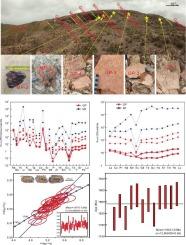Mineralogy, Geochemistry, and geochronology of the Paleoproterozoic pegmatite in the northern margin of the North China Craton, China: implications for U-Th-Pb-Nb-Ta-REE polymetallic mineralization
IF 3.6
2区 地球科学
Q1 GEOLOGY
引用次数: 0
Abstract
Rare metals represent strategically critical mineral resources, with rare-metal pegmatite deposits constituting one of their most significant sources. These deposits have become a focal point in contemporary geoscientific research and mineral exploration. This contribution provides the first documentation of extensively outcropped Paleoproterozoic rare-metal mineralized pegmatites along the northern margin of the North China Craton. A representative pegmatite dike from the Daqingshan area was selected for systematic investigation, including field geology, petrology, geochemistry, LA-ICP-MS zircon U-Pb geochronology, and EPMA U-Th-Pbtotal chemical dating of uraninite. Results reveal significant enrichment of U, Th, Pb, Nb, Ta, and rare earth elements (REE) during the evolution from non-mineralized graphic pegmatite to mineralized varieties. The mineralized pegmatite contains maximum concentrations of 47,300 ppm U, 1,490 ppm Th, 44,800 ppm Pb, 1,940 ppm Nb, 22,600 ppm Ta, and 69,636.3 ppm ΣREEs. These elements primarily occur in polycrase, fergusonite, allanite, uraninite, thorite, zircon, monazite, Y-bearing minerals, and xenotime. Zircon from non-mineralized graphic pegmatite yields a crystallization age of 1876 ± 14 Ma, whereas uraninite from mineralized pegmatite records a U-Th-Pbtotal chemical age of ∼ 1854 Ma. These zircons exhibit εHf(t) values ranging from −10.8 to −2.5, corresponding to two-stage Hf model ages (tDM2) of 2569–3018 Ma (mean = 2769 Ma). Integrated with field evidence and existing data, we propose that these pegmatites formed via melt migration following Paleoproterozoic high- to ultrahigh-temperature metamorphism and anatexis of ancient North China Craton crust. Their emplacement likely correlates with the late-stage assembly of the Columbia supercontinent during the transition from compressional to extensional tectonics. The extreme rare-metal enrichment predominantly resulted from magmatic fractional crystallization, with subordinate contributions from late-stage hydrothermal processes. This study advances metallogenic theories of Paleoproterozoic rare-metal pegmatites in China and provides critical insights for exploration targeting ancient rare-metal deposits.

华北克拉通北缘古元古代伟晶岩的矿物学、地球化学和年代学:U-Th-Pb-Nb-Ta-REE多金属成矿意义
稀有金属是具有重要战略意义的矿产资源,稀有金属伟晶岩矿床是其最重要的资源之一。这些矿床已成为当代地球科学研究和矿产勘探的焦点。这一贡献首次记录了华北克拉通北缘古元古代稀有金属矿化伟晶岩的广泛露头。选取大青山地区具有代表性的辉晶岩岩脉进行了野外地质、岩石学、地球化学、LA-ICP-MS锆石U-Pb年代学、EPMA铀- th - pbtotal化学定年等方面的系统研究。结果表明,在非矿化图形伟晶岩向矿化演化过程中,U、Th、Pb、Nb、Ta和稀土元素显著富集。矿化伟晶岩的最大浓度为47300 ppm U、1490 ppm Th、44800 ppm Pb、1940 ppm Nb、22600 ppm Ta和69636.3 ppm ΣREEs。这些元素主要存在于多长石、褐长石、allanite、铀矿、钍矿、锆石、独居石、含y矿物和xenotime中。来自未矿化的图形伟晶岩的锆石的结晶年龄为1876±14 Ma,而来自矿化伟晶岩的铀矿记录的U-Th-Pbtotal化学年龄为~ 1854 Ma。这些锆石的εHf(t)值在- 10.8 ~ - 2.5之间,对应于两阶段Hf模式年龄(tDM2)为2569 ~ 3018 Ma(平均= 2769 Ma)。综合野外证据和现有资料,认为这些伟晶岩是华北古克拉通古元古代高温-超高温变质和深熔作用后熔融迁移形成的。它们的就位可能与哥伦比亚超大陆在挤压构造向伸展构造过渡的后期组装有关。极端稀有金属富集主要由岩浆分馏结晶作用引起,后期热液作用次之。该研究进一步推进了中国古元古代稀有金属伟晶岩成矿理论,为寻找古代稀有金属矿床提供了重要的理论依据。
本文章由计算机程序翻译,如有差异,请以英文原文为准。
求助全文
约1分钟内获得全文
求助全文
来源期刊

Ore Geology Reviews
地学-地质学
CiteScore
6.50
自引率
27.30%
发文量
546
审稿时长
22.9 weeks
期刊介绍:
Ore Geology Reviews aims to familiarize all earth scientists with recent advances in a number of interconnected disciplines related to the study of, and search for, ore deposits. The reviews range from brief to longer contributions, but the journal preferentially publishes manuscripts that fill the niche between the commonly shorter journal articles and the comprehensive book coverages, and thus has a special appeal to many authors and readers.
 求助内容:
求助内容: 应助结果提醒方式:
应助结果提醒方式:


